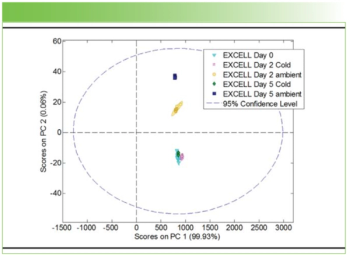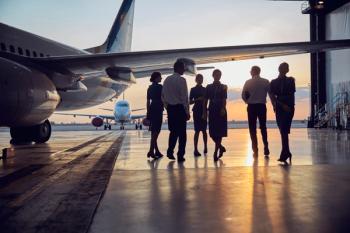
- Spectroscopy-10-01-2018
- Volume 33
- Issue 10
The 2018 Emerging Leader in Molecular Spectroscopy Award
This year’s honoree, Megan Thielges, is a pioneer in the development of vibrational probes for use with 2D IR spectroscopy, to reveal new information about the structures and dynamics of proteins.
This year’s award recipient, Megan Thielges, is a pioneer in the use of vibrational probes, in conjunction with two-dimensional infrared spectroscopy, to investigate the structures and dynamics of proteins, with the aim of understanding biological systems.
Megan Thielges, an associate professor of chemistry at Indiana University, has won the 2018 Emerging Leader in Molecular Spectroscopy Award, which is presented by Spectroscopy magazine. This annual award recognizes the achievements and aspirations of a talented young molecular spectroscopist, selected by an independent scientific committee. The award will be presented to Thielges at the SciX 2018 conference in October, where she will give a plenary lecture, and be honored in an award symposium.
Thielges earned her B.S. in biochemistry at Arizona State University. She went on to earn her PhD in biophysics from The Scripps Research Institute in La Jolla, California, in 2009. After three years as a postdoctoral fellow at Stanford University, she obtained her current position as an associate professor of Chemistry at Indiana University. She has published 11 papers as a principle investigator, and 22 as a postdoctoral, graduate, or undergraduate researcher. She has given 45 presentations and received six previous awards, as well as nominations for more. In addition to her research, Thielges has served as a reviewer for numerous scientific journals and on panels for many major national departments, including the National Institutes of Health, the National Science Foundation, and the Department of Energy.
The Challenges of Studying Protein Dynamics
The focus of Thielges's work is the study of protein structure and dynamics. Specifically, she is a pioneer in the use of multisite vibrational probes in conjunction with two-dimensional (2D) infrared (IR) spectroscopy to investigate the structures and dynamics of proteins.
The study of protein structure and function is a field of great interest. Proteins are the mediators of biological functions, and the structure of proteins is complex. The simplest level of protein structure is the primary structure, which consists of a sequence of amino acids joined to form a polypeptide chain. The order of the amino acids is what affects the structure and function of the protein; a single substitution can have life-threatening consequences. The secondary structure consists of a regular pattern of substructures that are formed because of the bonds between the various amino acids that compose the polypeptide chain. Proteins are not necessarily static in their conformations, however. In the field of protein dynamics, scientists look at the transitions a protein can make between different shapes that can occur on various scales of length or time, or both. These conformational changes have been shown to affect cellular functions, such as enzymatic activity and cellular signaling. These changes can happen on extremely fast timescales, making vibrational spectroscopy an excellent technique to observe them.
Given the dense nature of protein structure and the large amounts of molecules present, however, measured signals are congested, with large amounts of spectral overlap, making it is difficult to resolve the signals. A strategy for alleviating this signal congestion is to use a vibrational probe, which involves replacing one or more molecules in the structure with another whose vibrational signature operates in the so-called silent region of proteins, from about 1800 to 2500 cm-1, a region free from native protein signals (1). But developing effective vibrational probes is challenging. For a vibrational probe to be useful at a specific protein site, it must be strongly responsive to the physical property being investigated, be sensitive only to its immediate environment, cause little to no change to the original structure of interest, and be able to be incorporated into the system (2). This is where Thielges comes in.
Harnessing Vibrational Labels and 2D IR to Study Proteins
A major aspect of Thielges's work is the development of new vibrational labeling strategies. This is the crucial element of her contributions, according to Andrei Tokmakoff, a professor at the University of Chicago. "Her work has resulted in a toolbox that is opening up new ways of using IR spectroscopy in protein chemistry and biophysics," he said. "By combining these new labels with ultrafast 2D IR, Megan has [developed] a new way of studying protein chemistry, where fast dynamical processes involved in catalysis or binding are directly observed rather than inferred."
Studying Enzyme Catalysis
One example of this work was Thielges's use of vibrational labels to study cytochrome P450 enzymes, which play a role in the biological functions of molecular synthesis and metabolic processes. They are the major enzymes involved in the metabolism of medications, making their structure and function of particular interest to medical researchers. Thielges's work combining a new labeling techniques she developed (heme-bound CO, in this case) with IR and 2D IR spectroscopy has revealed different substrate binding configurations at the active site in these enzymes and enabled characterization of the fluctuations and exchange of these configurations. Her studies on P450 enzymes have illustrated the importance and power of 2D IR spectroscopy to measure protein dynamics occurring on very small timescales, as well as the technique's ability to gather information about the role of dynamics in biological activity (3). The National Institute of Health has awarded Thielges research grants for this work. By resolving different substrate binding configurations and the fast dynamics of conformational interchange, these experiments may one day enable understanding of the drug-degradation process undertaken by these enzymes.
Cellular Signaling
Another important application of Thielges's work is in the study of cellular signaling. The SH3 region in proteins is responsible for controlling certain signal transduction pathways, or the process through which a physical or a chemical signal is carried through a cell (cellular signaling). By introducing carbon-deuterium probes into the SH3 domain in yeast cells, Thielges was able to observe variations in the binding conformations of a proline-rich peptide (4). This study illustrated the power of IR spectroscopy to uncover rapidly interconverting states in a protein–peptide complex for the study of cellular signaling.
Thielges with one of her students, Sashary Ramos, in the laser laboratory at Indiana University.
Enabling the Study of Proteins at the Nanosecond Timescale
With 2D IR spectroscopy, it is possible to detect the signals from vibrational probes. However, the experimentally accessible timescale has typically been limited to the picosecond regime. This limitation has led to the need to develop 2D IR probes with longer vibrational lifetimes to extend the experimental timescale. Thielges's group has introduced and studied a novel IR probe, p-cyano-seleno-phenylalanine (CNSeF), for the study of protein dynamics by 2D IR spectroscopy, that is able to extend signal lifetime into the nanosecond range. The group demonstrates that this new probe could be detected on timescales 20–50 fold longer than could be achieved with the popular probe cyanophenylalanine (5).
Thielges giving a talk at the International Conference on Coherent Multidimensional Spectroscopy (CDMS 2018) in Seoul, Korea, in June 2018.
Recognition by Others
Tokmakoff wrote enthusiastically in support of Thielges's nomination for this award. He described her as an "ambitious and creative interdisciplinary scientist" who conducts "fearless research." What makes her stand out from her colleagues, he said, is not only that she is highly trained in two different scientific fields that rarely cross-protein and enzyme biochemistry and biophysics, and ultrafast laser spectroscopy-but that she is able to overcome the challenges of combining them successfully. As Tokmakoff said, leading spectroscopists often work with model systems (rather than meaningful biological problems), and chemical and molecular biologists are often unwilling to work with the long development process of new physical methods. "Megan is really the first of her kind-one who can do it all," he said. "She is truly a first class experimental scientist in both areas."
Michael Fayer, a professor of chemistry at Stanford University, where Thielges did postdoctoral research, agrees with Tokmakoff's appreciation of Thielges's combination of skills. "Megan is an amazing blend of a real biologist and a hard-core chemical physicist," he said. "This is her great strength that allows her to make important contributions to biology and biophysics."
Minhaeng Cho, the director of the IBS Center for Molecular Spectroscopy and Dynamics and a professor of chemistry at Korea University, first met Thielges at a conference three years ago, and the two have since collaborated on multiple occasions. According to Cho, Thielges's contributions to molecular spectroscopy started while she was still in graduate school. While at the Scripps Institute, he said, Thielges "introduced an extremely small and non-perturbative vibrational probe into proteins in a site-specific manner." This was important because of the spectral congestion that made using the plentiful C-H bonds to study the shapes and motions of proteins impossible. By replacing the hydrogen with deuterium at specifically targeted sites, Thielges demonstrated that the C-D stretch band, which falls into proteins' silent IR region, has "line shapes [that] are highly sensitive to protein conformations and secondary structures." Cho believes Thielges's research will lead her to address deep questions in biology, such as how protein–protein interactions and recognition are related to fast local fluctuation dynamics at the interface between proteins.
Floyd Romesberg, who was Thielges's graduate advisor at Scripps, says Thielges is a remarkable experimentalist. "She totally revolutionized our experimental approach to data collection, and her methods are still used by my group today," he said. "She also organized a study group for the students to teach themselves the theory underlying time-resolved non-linear spectroscopy."
Carlos Baiz, an assistant professor of chemistry at the University of Texas at Austin, describes Thielges as "creative, resourceful, [and] charismatic." He believes she will continue to "push the envelope" when developing more complex probes and methods to further evaluate protein structure and dynamics. He believes her new techniques will be more widely adopted by the ultrafast community in the coming years.
Thielges receiving an award for her work as a session chair at the International Conference on Coherent Multidimensional Spectroscopy in Seoul, Korea, in June 2018.
Peter Hamm at the University of Zurich conducts research that is very closely related to that of Thielges. But even though he characterizes their relationship as "a friendly competition," he nominated her for an award last year. Hamm describes Thielges's research as "an absolute prerequisite" for 2D IR spectroscopy to become a more versatile tool to study the structure and dynamics of proteins. "Her work is courageous," he says. "It does not seek the low-hanging fruit."
Summary
Megan Thielges's colleagues all believe she has a very bright and promising future ahead of her. Romesberg summarized this outlook well. "Megan will continue to combine sophisticated biology and spectroscopy," he said, "not only to explore protein dynamics, but to begin to elucidate how [they have] been tailored by evolution for biological function."
Megan Thielges is a pioneer at the forefront of combining biophysics with spectroscopy. She has been "fearless" and has overcome many practical obstacles to advance these two fields. She is a top-notch experimentalist who takes on big challenges. From organizing study groups to teach herself the theory behind time-resolved non-linear spectroscopy to developing methods as a graduate student that her advisor and his current group still use today, it seems there is nothing Megan Thielges can't do if she puts her mind to it.
References
(1) R. Adhikary, J. Zimmerman, and F.E. Romesberg, Chem. Rev. 117(3), 1927-1969 (2017).
(2) J. Ma, I.M. Pazos, W. Zhang, R.M. Culik, and F. Gai, Annu Rev Phys Chem. 66, 357-377 (2015).
(3) E.J. Basom, J.W. Spearman, and M.C. Thielges, J. Phys. Chem. B. 119, 6620-6627 (2016).
(4) R.E. Horness, E.J. Basom, J.P. Mayer, and M.C. Thielges, J. Am. Chem. Soc. 138, 1130-1133 (2016).
(5) S. Ramos, K.J. Scott, R.E. Horness, A.L. Le Sueur, and M.C. Thielges, Phys. Chem. Chem. Phys. 19, 10081-10086 (2017).
Nicole Olson is a freelance writer. Direct correspondence about this article to
Articles in this issue
over 7 years ago
Spectroscopy October 2018 Issue PDFover 7 years ago
Outliers, Part III: Dealing with Outliersover 7 years ago
Market Profile: Handheld SpectroscopyNewsletter
Get essential updates on the latest spectroscopy technologies, regulatory standards, and best practices—subscribe today to Spectroscopy.




